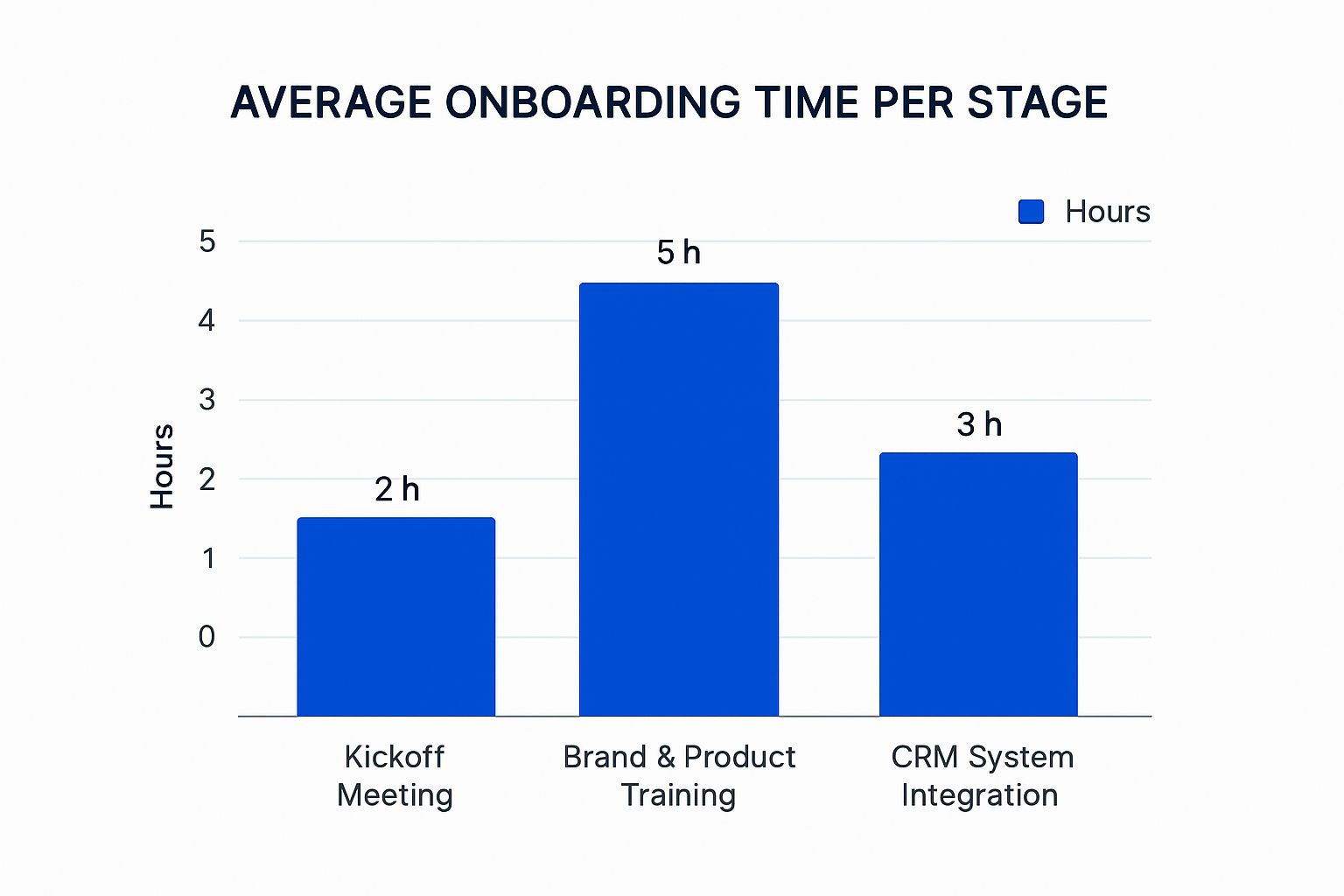When you hear "outsourcing lead generation", what comes to mind? It's simply the decision to bring in an external agency or a specialised team to handle the heavy lifting of finding and qualifying potential customers for your business.
The real magic is that it frees up your in-house sales team to do what they do best: focus on conversations with warm prospects and actually closing deals, rather than spending their days on cold outreach. For many UK businesses, this has become a go-to strategy for scaling efficiently while keeping overheads in check.
Why More UK Businesses are Outsourcing Lead Generation

Many businesses across the UK are coming to the same realisation: keeping lead generation entirely in-house isn't always the fastest or most effective route to growth. The move towards these kinds of strategic partnerships is about more than just offloading a few tasks; it's about gaining a genuine competitive edge in a very crowded market.
This is particularly true in complex sectors like technology and professional services. Think about a UK-based SaaS startup. Their genius lies in product development, not in the painstaking process of building and training a sales development team from the ground up. By outsourcing their lead generation, they get instant access to a skilled team without the eye-watering investment in recruitment, salaries, and continuous training.
The True Cost of an In-House Team
When you build a team internally, the expenses pile up far beyond the monthly payslip. There's a whole raft of hidden costs that can quietly eat into your budget and put the brakes on your growth.
You have to account for the full picture:
- Recruitment Fees: The cost of using an agency or the valuable time your HR and management team sink into sourcing and interviewing.
- Salaries & Benefits: This isn't just the salary. It's National Insurance, pension contributions, and any health benefits you offer.
- Training & Onboarding: The initial ramp-up period where a new hire is still learning the ropes and not yet hitting their targets.
- The Tech Stack: Monthly subscriptions for your CRM, sales intelligence tools like Lusha or ZoomInfo, and email automation platforms.
- Management Overhead: The crucial time your senior staff have to dedicate to managing, coaching, and motivating the team.
For many small to medium-sized enterprises (SMEs), these costs create a serious financial hurdle, making it tough to build a predictable sales pipeline.
Building an in-house team from scratch has its merits, especially for long-term control. However, the initial investment and ongoing costs can be daunting. Outsourcing, on the other hand, offers immediate access to expertise and technology without the long-term financial commitment.
Let's break down the key differences.
In-House vs Outsourced Lead Generation: A Quick Comparison
Ultimately, the choice depends on your company's stage, resources, and growth objectives. For many, outsourcing provides a more agile and cost-effective way to kickstart and scale their sales efforts.
Tapping into Specialised Expertise Instantly
An established agency isn’t just a group of callers; they bring refined processes, battle-tested outreach strategies, and a deep understanding of what works across different industries. They offer a level of data analysis and market insight that might take an internal team years to develop on their own.
It's also worth taking a moment to clarify your goals. Understanding the difference between Demand Generation vs. Lead Generation is crucial to ensure your overall strategy is aligned from the start.
A great outsourced partner doesn’t just generate leads; they become an intelligence hub for your business, providing insights into which messaging resonates, what titles are responding, and which market segments are most promising.
By engaging with an outsourcing company, you effectively change lead generation from a fixed operational cost into a flexible, results-driven investment. This agility means you can redirect your best internal resources—like your top developers or marketing minds—back to their core roles, driving innovation while the experts keep your sales pipeline consistently full.
Finding the Right Lead Generation Partner

Choosing a lead generation partner is easily the most critical decision you'll make in this entire process. This isn't just about hiring a service; you're handing over a vital part of your sales funnel to an outside team. The aim is to find a true partner who acts like a natural extension of your own company, not just another line item on your expenses.
The search for that perfect fit doesn't start with scrolling through agency websites. It starts with a hard look in the mirror. Before you can properly vet anyone else, you need a rock-solid understanding of who you’re actually trying to reach.
Define Your Ideal Customer First
Hopping on discovery calls with agencies without a crystal-clear Ideal Customer Profile (ICP) is a recipe for disaster. It wastes everyone's time and leads to mismatched expectations right out of the gate. Your ICP is the foundation for any successful lead generation campaign—it's the detailed blueprint of the company you are perfectly positioned to help.
Think of it this way: you wouldn't ask a builder to start on a house without architectural plans. So why would you ask an agency to find your ideal customers if you haven't defined who they are?
Your ICP needs to go way beyond basic firmographics. Get granular.
- Industry & Niche: Are you targeting FinTech, or are you really targeting London-based FinTechs that specialise in payment processing? The difference matters.
- Company Size: Be specific about employee count and annual revenue. A 50-person company has completely different needs and buying signals than a 500-person enterprise.
- Technology Stack: What software or tools do they already use? This can be a huge qualifying signal and a great way to personalise your outreach.
- Pain Points: What specific business headaches does your solution solve for them?
With a detailed ICP in your back pocket, you’re no longer just looking for any lead generation company. You're looking for a partner with proven, hands-on experience in reaching that exact audience.
Evaluate Partners on Specialisation, Not Generalisation
The market is flooded with agencies claiming they can do it all for everyone. While that might sound appealing, specialist knowledge is where the real value lies. A partner with deep experience in your niche will already speak the language, understand the challenges, and know the buying triggers of your audience. They can hit the ground running.
For example, an agency that excels at drumming up leads for SaaS companies will use entirely different tactics and tools than one that specialises in manufacturing. The UK market is home to some fantastic specialists. Companies like Pearl Lemon Leads, Cleverly, and Lead Gen Dept have built their reputations on using sharp techniques and data analytics to connect with the right prospects, ensuring every lead is a strong fit. You can find out more about the UK's top lead generation agencies to see what’s out there.
This kind of specialisation is what you should be looking for.
Key Questions to Ask Potential Partners
Once you've shortlisted a few agencies that look like a good fit, it's time to dig deeper. Your goal is to get past the sales pitch and truly understand their process, their approach to transparency, and how they measure success. Coming prepared with a list of questions is the best way to do that.
Here are a few essential questions to get your conversations started:
- Can you share a case study from a client with a sales cycle similar to ours? This is far more telling than just asking about clients in the same industry. It proves they understand the nuances of your buying journey.
- What's your process for handling unqualified leads? A great partner will have a solid feedback loop. They should be eager to know why a lead wasn't a fit so they can fine-tune their targeting.
- How do you source and verify your contact data? Steer clear of partners who rely on static, purchased lists. You need a team that builds fresh, validated lists for every campaign to guarantee accuracy and compliance.
- What does your standard reporting look like? Ask for a sample report. It should be clear, concise, and focused on metrics that actually matter—like meetings booked and opportunity conversion rates—not just vanity metrics like the number of emails sent.
- How will your team integrate with our CRM and sales workflow? A smooth lead handoff is non-negotiable. They must be able to work within your existing systems to avoid creating extra work and friction for your sales reps.
Remember, you're interviewing for a long-term partnership. The best agencies will be just as interested in qualifying you as a client as you are in qualifying them. They want to be certain they can actually deliver the results your business needs.
How to Create a Seamless Onboarding Process
You’ve signed the contract and chosen your new lead-gen partner. Great. But the real work starts now. Honestly, a strong start is everything, and where I see most of these partnerships go wrong is in a rushed or sloppy onboarding process. It’s the number one cause of misaligned expectations and off-brand messaging down the line.
A smooth onboarding isn't just a welcome meeting. It's a proper, structured process designed to turn an outside agency into a genuine extension of your own team. You want them to have the knowledge, tools, and confidence to represent your brand flawlessly from the very first email they send.
The Kick-Off Meeting Is Non-Negotiable
The entire foundation of your partnership gets laid in that first kick-off meeting. This isn't just a formality; it’s a critical session to get everyone on the same page about what success actually looks like. It’s your chance to turn high-level goals into hard, measurable objectives.
To get the most out of this, you need to walk in ready to nail down a few key things:
- Key Performance Indicators (KPIs): Don't settle for vague targets. You need to define specifics, like the exact number of Sales Qualified Leads (SQLs) you expect each month, your target lead-to-meeting conversion rate, and the cost per appointment you’re aiming for.
- Communication Cadence: Agree on a clear rhythm for how you'll talk. Is it a weekly check-in call? A shared Slack channel for quick questions? Who are the main points of contact on both sides? Iron this out now.
- Reporting Structure: Decide what gets tracked and how often you'll see the numbers. Any decent partner will offer a transparent dashboard, but you need to make sure it’s tracking the metrics that actually matter to your business.
This meeting truly sets the tone for the entire relationship. You're building a collaborative partnership here, not just a transactional one.
Equipping Your Partner for Success
Your new partner can only be as good as the information you give them. To speak with any authority, they need to understand your business almost as well as you do. Drip-feeding them information over weeks just kills momentum before it even starts.
Instead, put together a complete onboarding package right from the get-go. It should include:
- Deep-Dive Product/Service Training: Go way beyond the sales brochure. Give them access to demos, technical documents, and your best sales collateral. Let them experience your solution through a customer's eyes.
- Detailed Buyer Personas: Share the nitty-gritty details of your Ideal Customer Profile (ICP). What are their biggest headaches? What makes them start looking for a solution? What kind of language do they use?
- Comprehensive Brand Guidelines: This means giving them your company's tone of voice, key messaging pillars, and a clear list of industry jargon to use (and what to avoid). This ensures your brand sounds like your brand, no matter who is speaking.
The infographic below gives a realistic idea of the time you should be dedicating to these early stages. As you can see, the training part is the biggest piece of the puzzle.

It makes sense that brand and product immersion takes the most time—it’s the absolute bedrock of authentic and effective outreach.
Integrating Systems for a Smooth Workflow
This is where things often get clunky. If the technical handoff between your partner's team and your sales team isn’t seamless, you create friction, and that’s how good leads fall through the cracks. The goal is a completely smooth flow of information from the first touchpoint right through to a closed deal.
The ultimate test of a good onboarding process is whether your internal sales team feels like the outsourced team is working with them, not just for them. A smooth technical integration is the key to achieving this synergy.
Practically, this means hooking their outreach tools directly into your Customer Relationship Management (CRM) system. When a lead is qualified and a meeting gets booked, that data should pop up in your CRM instantly, complete with all the conversation history and context. This lets your sales reps jump straight into the conversation without missing a beat.
For more ideas on how to structure this, our guide on effective remote employee onboarding has some great principles that apply perfectly to this kind of partnership.
Managing the Partnership and Measuring True ROI
Once your new lead generation partner is up and running, the real work begins. The initial setup is done, but now the focus has to shift to managing the relationship for sustained performance. This is where you move past simply counting leads and start digging into what really impacts your bottom line: revenue.
Effective management all comes down to a solid feedback loop built on total transparency. Your partner needs to know what’s working, but it’s even more critical they know what isn’t. This isn't about micromanaging them; it’s about working together to refine the approach so the campaigns continually improve and drive genuine growth.
Moving Beyond Vanity Metrics
It’s incredibly easy to get caught up in activity metrics. Things like the number of calls made or emails sent feel productive, but they tell you absolutely nothing about the quality of those interactions or their effect on your sales pipeline. A busy campaign isn't always a successful one.
To get a real feel for performance, you have to track the numbers that directly connect to revenue. This means pulling your focus away from the top of the funnel and zeroing in on bottom-of-funnel results.
Here’s where you should be looking:
- Lead-to-Opportunity Conversion Rate: Of all the leads your partner passes over, what percentage actually become qualified sales opportunities in your CRM? This is the ultimate test of lead quality.
- Cost Per Qualified Lead (CPL): Don't just look at the raw cost per lead. Calculate the cost for each lead that your sales team accepts as qualified. This gives you a much sharper picture of efficiency.
- Sales Cycle Length: Are the leads from your outsourced partner closing faster or slower than leads from other channels? A shorter sales cycle is often a sign of a better-qualified, more motivated prospect.
Key Metrics for Measuring Outsourcing Success
To truly gauge the success of your partnership, you need a balanced view of performance. The table below outlines the crucial metrics to track, moving from tactical activity to the strategic results that really matter.
By tracking this mix of metrics, you get a complete story—from the initial effort to the final impact on your company's revenue. A deeper understanding of essential lead generation KPIs will help you connect your marketing spend to predictable growth.
Calculating Your True ROI
While individual KPIs are vital, the ultimate measure of success is your return on investment (ROI). Figuring this out doesn't need to be a complex accounting exercise. A simple formula can give you a crystal-clear view of the financial impact.
Here's the calculation to use:
ROI (%) = [(Revenue from Outsourced Leads - Total Outsourcing Cost) / Total Outsourcing Cost] x 100
Let's say you spent £15,000 on the service in a quarter, and the leads generated brought in £75,000 in new business. Your ROI would be a very healthy 400%. This single number cuts through all the noise and proves the concrete value the partnership is delivering.
A positive ROI is the clearest signal you can get that your outsourcing strategy is working. It shifts the service from being just another operational cost to a proven growth engine for your business.
Fostering a Culture of Constructive Feedback
Think of your outsourced team as an extension of your own. Just like any internal team, they need regular, constructive feedback to hit their peak performance. The best partnerships are built on open dialogue and a shared goal of constantly improving results.
Set up regular performance reviews—weekly or bi-weekly calls work well—to go over the data. But don't just stick to the numbers. Share the qualitative feedback you're hearing from your sales team. Was a particular lead not quite the right fit? Was the messaging a little off for a certain industry? This kind of ground-level insight is gold for refining campaign targeting and messaging.
This process is a fundamental part of managing the relationship. To build a strong, productive partnership, it helps to follow some established principles. You can dig deeper into this with our guide on vendor management best practices.
Common Outsourcing Pitfalls and How to Avoid Them

Outsourcing lead generation can feel like a silver bullet for growth, but it's not a 'set it and forget it' solution. I've seen plenty of these partnerships fizzle out, and the reasons are nearly always preventable. If you're not careful, you can end up burning through your budget with very little to show for it.
The most successful relationships I've witnessed are true partnerships. The problems start when you treat the agency like a disconnected vendor instead of an extension of your own team. Let’s walk through the most common traps and, more importantly, how to sidestep them from the beginning.
Misalignment on Lead Quality
This is the big one. In fact, it's the number one reason these arrangements fail. You're expecting sales-ready opportunities, but what lands in your team's lap is a list of contacts who are barely lukewarm. The result? A frustrated sales team, wasted time, and a total loss of confidence in the entire initiative.
This breakdown happens when the definition of a 'good lead' is fuzzy. Your partner's idea of a qualified prospect and your sales team's reality can be worlds apart if you don't nail down the specifics.
Don't just hand over a one-page Ideal Customer Profile (ICP) and hope for the best. To avoid this, you need to co-create a detailed lead scoring document that leaves no room for interpretation. Get granular and assign points for different attributes.
- Firmographics: Award points for the perfect industry, company size, and location.
- Technographics: Is the prospect using a competitor's software? Or perhaps a tool that integrates perfectly with yours? These are huge buying signals.
- Engagement: There's a massive difference between someone who downloaded a top-of-funnel whitepaper and someone who requested a demo. Score them accordingly.
This shared document becomes your single source of truth, eliminating the grey areas and ensuring everyone is chasing the same definition of quality.
Poor Communication and Off-Brand Messaging
Nothing tanks your reputation faster than outreach that feels generic, aggressive, or just plain wrong. When an outsourced team doesn't truly understand your company's voice, their messaging can alienate prospects and make your business look unprofessional. At worst, you end up looking like a spammer.
This is a classic symptom of a rushed onboarding process where brand immersion gets overlooked. Your partner has to sound like they're sitting in your office.
A simple, proactive solution is to establish a shared communication hub from day one. A dedicated Slack channel is perfect for this. It allows for quick-fire questions, real-time feedback on messaging, and a much more collaborative, less formal way of working together.
On top of that, give them a "brand messaging playbook." This shouldn't just be your standard brand guidelines. Include examples of past successful email campaigns, a rundown of common customer objections (and how you handle them), and a glossary of industry-specific terms to use and avoid.
Unclear Reporting That Hides Poor Performance
Another classic pitfall is getting reports packed with vanity metrics that look great on paper but mean nothing for your bottom line. A high number of calls made or emails sent is utterly meaningless if it's not turning into qualified meetings and, eventually, new business.
Vague reporting is the perfect camouflage for poor performance, allowing an underperforming partner to fly under the radar for weeks or even months while your budget evaporates. You need a clear, direct line of sight from their activity to your revenue.
The fix is to agree on the 3-5 key performance indicators (KPIs) that actually matter before the campaign even starts. Insist on a reporting dashboard that puts these front and centre.
Your must-track metrics should include:
- Lead-to-Meeting Conversion Rate: This is your best, most honest indicator of lead quality.
- Cost Per Sales Qualified Lead (SQL): This tells you if the partnership is financially efficient.
- Pipeline Value Generated: This directly connects their efforts to potential revenue.
When you focus on these outcome-driven numbers, you hold both sides accountable for results, not just activity. That kind of transparency is what builds trust and keeps the partnership centred on what really matters: driving genuine growth.
Your Outsourcing Lead Generation Questions Answered
Deciding to outsource your lead generation is a big move, and it's totally normal to have a long list of questions before you dive in. It’s a major strategic investment, after all. Let's walk through some of the most common things UK businesses ask us when they're considering bringing a partner on board.
How Much Does Outsourcing Lead Generation Cost in the UK?
This is usually the first question on everyone's mind, but there's no simple, one-size-fits-all answer. The cost can swing quite a bit depending on who you partner with, how complex your sales process is, and the industry you operate in.
Generally, you'll come across a few different ways agencies structure their fees. A monthly retainer is common, which might start at a couple of thousand pounds for a smaller business and scale up significantly for a larger enterprise campaign.
You'll also see pay-per-lead or pay-per-appointment models. These can sound fantastic because you're paying for a specific outcome, but be careful. The real value isn't just in the cost per lead, but in the long-term ROI and, crucially, the quality of the leads you're actually getting.
Will an Outsourced Team Understand My Business Well Enough?
It’s a fair question. No one lives and breathes your business quite like you and your team. An external partner won’t have that same ingrained knowledge from day one, but that’s precisely why a thorough, well-structured onboarding process is non-negotiable.
The best agencies are experts at becoming experts. They make it their mission to get under the skin of your business and your industry. The secret to making this work is treating them like a genuine extension of your own team. Give them access to product training, keep them in the loop on brand updates, and offer open, honest feedback. That’s how you close any knowledge gaps.
A great partnership is a two-way street. Your commitment to educating the outsourced team directly correlates with their ability to represent your brand authentically and effectively. They can only be as good as the information you provide.
How Long Until I See Results from an Outsourced Campaign?
Patience is a virtue here. While you'll see activity almost immediately—calls being made, emails going out—it's not an overnight switch. Realistically, you should expect it to take around three to six months to build up a steady, predictable pipeline of quality leads and see a clear return on your investment.
Think of the first month or two as the "dialling-in" phase. This is when your new partner is testing messaging, figuring out what resonates with your audience, and building that initial momentum. In the early days, keep an eye on leading indicators like prospect engagement and connection rates; these are the first signs that things are moving in the right direction.
How Do I Ensure the Leads I Receive Are High Quality?
Lead quality all comes down to the quality of your brief and your ongoing collaboration. If you want great leads, you need to be crystal clear from the outset about what "great" actually looks like.
Sit down with your partner and hammer out a precise definition of a Sales Qualified Lead (SQL). This can't just be a fuzzy idea; it needs to be a concrete checklist. What's the ideal company size? What industries are you targeting? Which job titles hold the buying power?
Just as important is creating a rock-solid feedback loop. Your sales team needs an easy way to report back on every single lead. Was it a good fit? Why or why not? This constant stream of information allows your outsourced team to fine-tune their targeting and get smarter with every conversation, ensuring the quality just keeps getting better.

